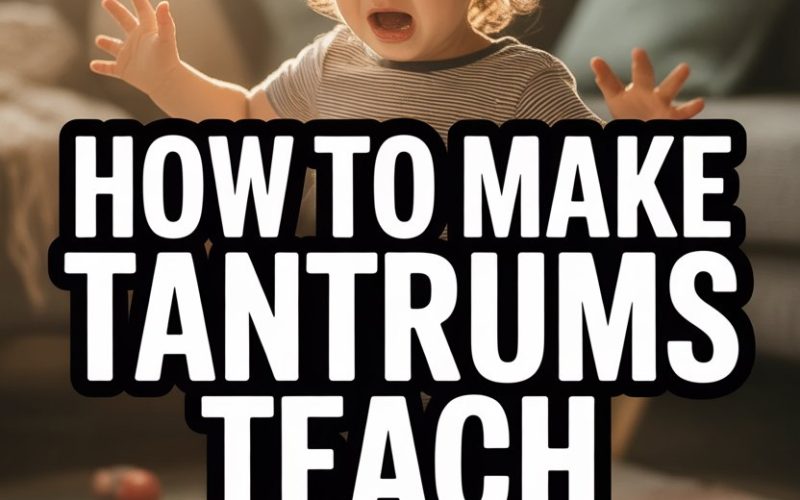Ah, tantrums—the sound of childhood, the soundtrack of parenthood, the universal reminder that small humans come with big feelings.
If you’ve ever found yourself wondering whether your child’s ear-splitting shriek is a sign of future opera stardom or just another Tuesday, you’re in solid company.
But those red-faced, spaghetti-limbed meltdowns? They’re not pointless.
Tantrums are absolutely bursting with potential (yes, really) to help your child learn self-control. Even if they arrive at wildly inconvenient moments—like checkout lanes, or smack in the middle of a Zoom call.
Why Tantrums Aren’t the End of the World
There’s a general belief that tantrums mean you’re doing something wrong. Not true.
According to child development experts at Child Mind Institute, tantrums are a normal part of growing up, especially during the toddler and preschool years. Your child’s brain is still under construction, especially in the self-control department.
In fact, tantrums are your child’s way of saying, “I have a feeling and I don’t know what to do with it.”
The good news? They’re learning. Bit by snotty bit.
Embracing the Slow Burn
When it comes to teaching self-control, patience is your best friend (even when you’d really like to trade it in for noise-canceling headphones).
Self-control isn’t a light switch—it’s more like a dimmer knob, and the wiring takes years.
Each tantrum is a micro-lesson. Every time you support your child through a meltdown, you’re helping them wire up their emotional brakes. That’s worth all the foot-stomping, right?
Keep Calm and Model On
You probably know that classic airplane advice: “Put on your own oxygen mask first.” It applies here too.
Kids learn self-control by watching it in action, which means your reaction is at least as important as theirs.
When tempers flare, and you manage to not join your child in rolling around on the floor, you’re showing them what calm looks like.
According to research published in Development Psychology, modeling self-regulation helps children develop those same skills.
It’s not about never feeling frustrated. It’s about showing how to handle it. Deep breath, maybe a muttered “serenity now,” and then dealing with it—out loud, so your child sees the gears turning.
Naming the Beast
Little ones often don’t have the words for what’s going on inside. Is it anger? Disappointment? Just plain overtired? Help them name it.
Try saying, “You feel really mad because you wanted another biscuit and it’s all gone.”
This not only helps your child feel understood, but emotion coaching is linked with stronger emotional regulation down the line.
And if they’re too far gone to listen? Skip the lecture and save it for a calmer moment. Sometimes, all you can do is ride the storm with them.
Boundaries Are the Reins, Not the Cage
Teaching self-control doesn’t mean letting your child have their way to avoid a meltdown. Quite the opposite.
Boundaries are what help kids feel safe—and repeatedly reinforced boundaries are what teach them to adapt, even if they test them (loudly, and often in public).
Set your limits, whether it’s “We only have one cartoon before bed,” or “We can’t hit, even when we’re upset.” Hold the line with a calm, neutral tone. It’s not personal—it’s the rules.
At first, your child’s brain will seem determined to test whether you really mean it. Stand firm. Over time, consistency will help those self-control muscles grow.
The Power of Pause
Kids are experts at the instant reaction; impulse control is a work in progress. One of the best self-control tools you can teach is the pause.
During a tantrum, model the pause yourself (“I’m feeling angry, so I’m going to take a few deep breaths”).
For older kids, try teaching them to “blow out the candles” (pretend their fingers are birthday candles and blow them out, one by one).
Building in small moments to stop and think—even if it’s just a second—gives your child’s brain a chance to catch up with their feelings.
After the Storm: Repair and Reflect
No one gets it right every time. Maybe you raised your voice, or lost your cool, or resorted to bribing with biscuits (we’ve all been there).
What matters most is what happens after. Once tempers have cooled, talk about what happened. “We both got really upset. Next time, what could we do differently?”
This isn’t about shaming or blaming. It’s about showing that everyone’s learning, even grown-ups.
According to Dr. Daniel Siegel, reflecting on tough moments helps strengthen brain connections for better self-control in the future.
Practice Makes Progress
Self-control gets stronger with practice, just like any other skill. Look for small ways to “train” together outside of the tantrum zone.
Play games that require waiting or turn-taking, like ‘Simon Says’ or ‘Red Light, Green Light’.
Even simple everyday moments—waiting for the toast to pop, taking turns choosing songs in the car—are chances to flex those patience muscles.
And don’t forget: praise the effort, not just the outcome. “You waited your turn! That was hard, and you did it.”
Don’t Expect Miracles Overnight
Much as we’d love to promise tantrum-free mornings after reading this, self-control is a slow grower. Some children naturally struggle more than others.
If tantrums seem extreme, last for ages, or come with aggressive behavior, reach out to a paediatrician or a child psychologist for guidance.
Sometimes, extra support can make all the difference.
When Tantrums Happen in Public
Every parent has a horror story involving a supermarket, a crowd, and a child who’s lost the plot. Public tantrums feel embarrassing, but you’re not alone.
Try to focus on your child, not on the invisible audience. Offer comfort and reassurance without caving to unreasonable demands.
If you need to, scoop them up and move somewhere quieter.
Most bystanders are more sympathetic than you’d think—they’ve probably been there too (or they’re just grateful it’s not their turn).
Your Child’s Brain is Under Construction
Here’s the good news: all those tantrums are helping your child’s brain learn the ropes.
The prefrontal cortex—the bit in charge of self-control—isn’t fully built until adulthood. Every meltdown is a messy rehearsal for better regulation later.
Your job isn’t to eliminate tantrums entirely. It’s to help your child learn from them.
With steady support, clear limits, and a bit of humour, you’re helping turn emotional eruptions into valuable practice for life.
It’s a Marathon, Not a Sprint
Tantrums aren’t just noise and chaos—they’re opportunities for growth (and, yes, a chance to work on your own deep-breathing techniques).
By staying calm, setting boundaries, talking about feelings, and practising self-control in small ways every day, you’re doing the long, sometimes loud, work of raising a child who can handle their big feelings.
And if you ever need a reminder that you’re not alone, just listen for the sound of another parent’s trolley wheels squeaking away from aisle three, trailed by a small child howling about biscuits. Solidarity, friends.





